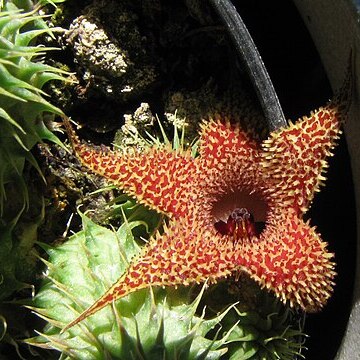Perennial succulent. Stems erect, cylindrical to narrowly ovoid, 15-60(-180) x 7-15 mm, grey-green, (9)10-16(-24)-angled with vertical to spiralled rows of tubercles, each tubercle tipped with a 2-8 mm long bristle making the stems look ‘furry’. Flowers 1-5; pedicels 2-8 mm long. Sepals 8.5-12.5 mm long. Corolla 30-50 mm in diam., cream-coloured to yellowish with small red spots; tube campanulate; lobes spreading to recurved, 12-22 mm long; papillate to halfway inside tube, papillae cylindrical, up to 1 mm long, sometimes bearing a small hair. Corona maroon; outer lobes spreading, variable, ± rectangular to triangular; inner lobes erect, dorsiventrally flattened, 2.0-2.5 mm long, tapering to clavate, tuberculate apex.
Like H. barbata but stems cylindrical, with tubercles arranged into 10-16 rows, tubercles tapering into a slender bristle 2-8 mm long, corolla campanulate, inside with conspicuous papillae, each with a minute, apical bristle, inner corona lobes with bristly, clavate tips.
Leafless succulent to 10 cm, with stems cylindrical and tesselated, covered in soft bristles arranged roughly into 10-16, often spiralling rows; sap clear. Flowers like H. longii.

